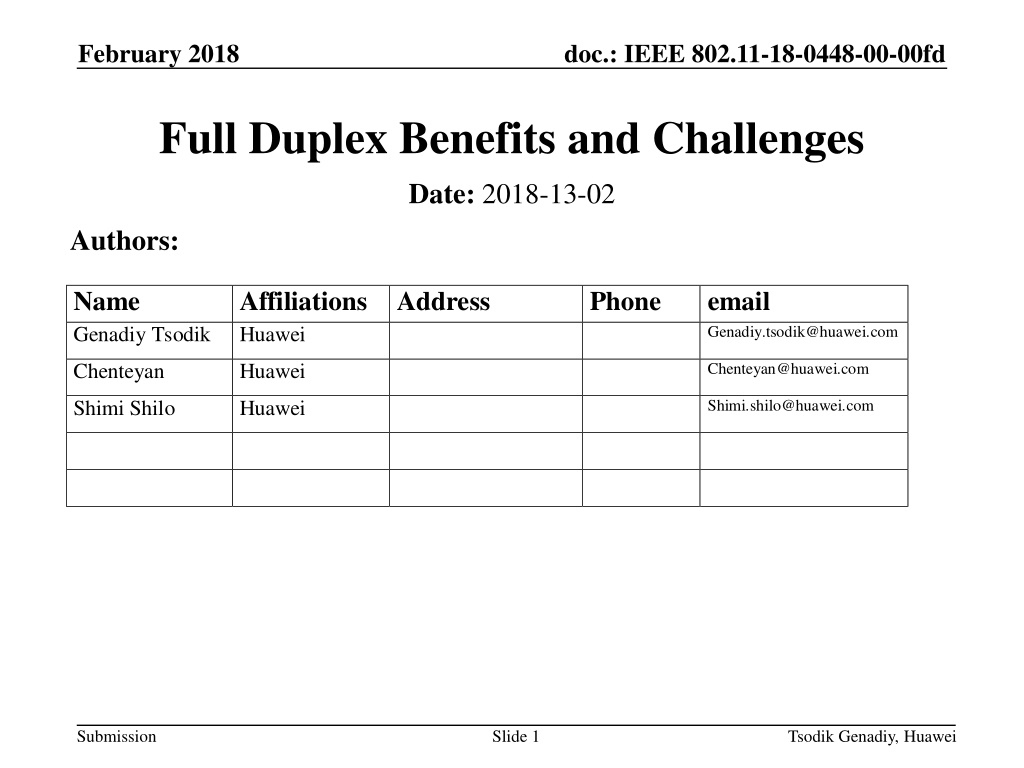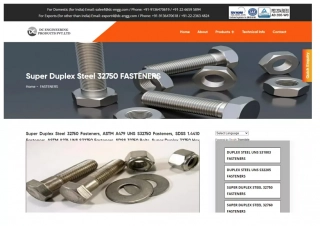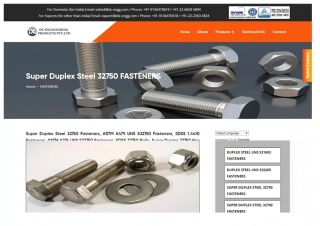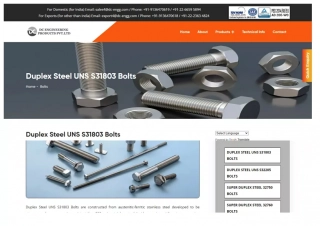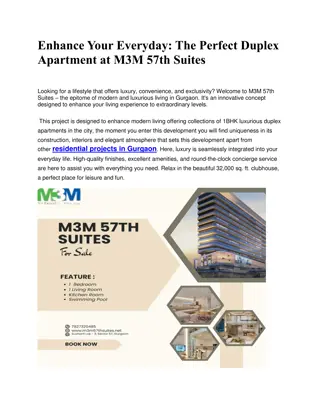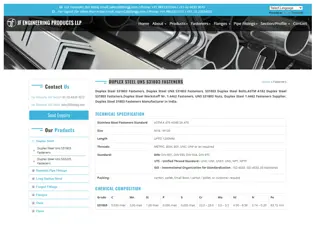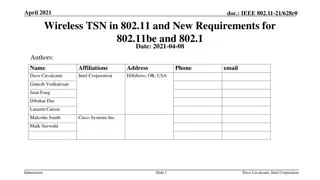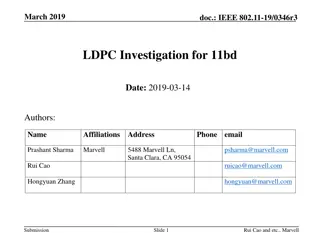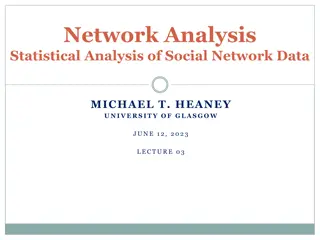Full Duplex Technology for 802.11 Networks
Investigating the potential benefits and challenges of using simultaneous transmission and reception (STR) as a candidate for Full Duplex (FD) technology in the IEEE 802.11 network. Highlighting the advantages of STR such as increased throughput, reduced latency, collision prevention, and network issue relaxation. Delving into the physical, link-level, and system-level aspects of STR implementation including self-interference cancellation issues and necessary conditions for maximizing gain.
Download Presentation

Please find below an Image/Link to download the presentation.
The content on the website is provided AS IS for your information and personal use only. It may not be sold, licensed, or shared on other websites without obtaining consent from the author.If you encounter any issues during the download, it is possible that the publisher has removed the file from their server.
You are allowed to download the files provided on this website for personal or commercial use, subject to the condition that they are used lawfully. All files are the property of their respective owners.
The content on the website is provided AS IS for your information and personal use only. It may not be sold, licensed, or shared on other websites without obtaining consent from the author.
E N D
Presentation Transcript
February 2018 doc.: IEEE 802.11-18-0448-00-00fd Full Duplex Benefits and Challenges Date: 2018-13-02 Authors: Name Genadiy Tsodik Affiliations Address Huawei Phone email Genadiy.tsodik@huawei.com Chenteyan Huawei Chenteyan@huawei.com Shimi Shilo Huawei Shimi.shilo@huawei.com Submission Slide 1 Tsodik Genadiy, Huawei
February 2018 doc.: IEEE 802.11-18-0448-00-00fd Background Simultaneous Transmission and Reception (STR) is now being investigated as a candidate for Full Duplex (FD) technology for the next generation of 802.11 [1] The idea to allow transmission and reception using the same time and frequency resources is not new for wireless communications; however it should be investigated deeply with application to 802.11 technology We believe that FD can be a key technology for the next generation of Wi-Fi Hence, we are trying to determine what has to be done in order to achieve the theoretical benefits of STR in Wi-Fi networks Submission Slide 2 Tsodik Genadiy, Huawei
February 2018 doc.: IEEE 802.11-18-0448-00-00fd Major Potential Benefits of STR The major benefits of STR technology are: Throughput gain twice the amount of data transmitted on same resources Lower latency we can reduce latency per specific STA or entire network (for example - ACK time, SIFS period reduction, etc.) Collision reduction DL signal prevents potential hidden nodes from transmitting during UL Network issues relaxation for example, a solution for relay-based networks (multiple relays supporting FD can transmit simultaneously) Those are very promising theoretical benefits that can bring Wi- Fi technology to new heights We are now trying to understand how to support it in practice!!! Submission Slide 3 Tsodik Genadiy, Huawei
February 2018 doc.: IEEE 802.11-18-0448-00-00fd STR Aspects Physical aspects: Self-Interference Cancellation (SIC) is the most complex problem to be solved for STR feasibility Link Level Aspects: What are the conditions to achieve maximum gain? What information exchange is required to apply STR? System Level Aspects Should non-AP STAs support STR? Which STAs can participate in STR transmission? Is there any relationship between STAs involved in STR? What is the system level overhead required for STR benefit? System Level STA Rx Link Level STA Tx Tx Rx Physical Level Submission Slide 4 Tsodik Genadiy, Huawei
February 2018 doc.: IEEE 802.11-18-0448-00-00fd Self Interference Cancellation Tx signal produces an interference that needs to be mitigated on Rx side to be below the expected noise level The main interference components are: Internal reflections 15-20dB lower than Tx signal Non-linear components 30-40dB lower than Tx signal Multipath 50-60dB lower than Tx signal Most of the research papers (for instance [2]) divide the SIC problem into two parts: Analog SIC reduces the strongest components Digital SIC completes the action on sampled signal to reduce the interference below the noise floor We also need to define an efficient SIC calibration procedures with minimum overhead 110dB Interference Signal 20dBm Antenna Isolation 95dB 5dBm Nonlinearity 75dB -15dBm Multipath -35dBm 55dB -90dBm Noise Floor Submission Slide 5 Tsodik Genadiy, Huawei
February 2018 doc.: IEEE 802.11-18-0448-00-00fd SIC Research Challenges Practical LNA can handle signal below -30dBm which means approximately 50-60dB should be removed in RF In order to reduce the interference below the noise floor, we need additional digital cancellation of about 60dB Moreover, we need to consider higher dynamic range due to the difference between the desired signal and the interference We summarize the challenges of the self-interference cancellation as: Design of complex analog and digital blocks Minimize the SNR degradation (e.g. A/D with higher dynamic range) Define efficient calibration procedures (that do not degrade performance) Submission Slide 6 Tsodik Genadiy, Huawei
February 2018 doc.: IEEE 802.11-18-0448-00-00fd Link Level Aspects Assuming we solved the problem of self-interference cancellation, we need to know how to decide whether to apply FD or half-duplex? The following aspects may impact link budget: compare Change in RF properties SNR is limited due to residual interference SNRFD SNRHD Noise floor is higher due to different RF settings We need to know how to improve the throughput of the specific transmission compared to half duplex An STR-relatedlink budget definition is required to allow accurate decisions! Submission Slide 7 Tsodik Genadiy, Huawei
February 2018 doc.: IEEE 802.11-18-0448-00-00fd System Level Aspects System level aspects should be considered in order to maintain the benefits of STR in the entire network We recognize two main topics: overhead issues and system protocols System level overhead questions (we want to minimize overhead) Which additional resources (frames/signal/fields) are needed to support STR? Which STAs can be involved in STR, what is required to make the right decision? System level protocols (ensure the gain is maximized) Can we combine STR and MIMO/OFDMA? How we keep backward compatibility in presence of STR? Submission Slide 8 Tsodik Genadiy, Huawei
February 2018 doc.: IEEE 802.11-18-0448-00-00fd Summary This presentation explains which aspects have to be addressed to support the theoretical benefits of STR in the next generation of 802.11 We believe that fundamental aspects of research should be: SIC aspects Link level aspects System level aspects We think that the main targets of the Full Duplex TIG should be: Focusing on identifying where full duplex indeed reaches its theoretical benefits with respect to fundamental aspects above Justifying the throughput gain compared with the existing Wi-Fi systems Submission Slide 9 Tsodik Genadiy, Huawei
February 2018 doc.: IEEE 802.11-18-0448-00-00fd References [1] IEEE 802.11-18/0191r0, 802.11 Full Duplex [2] Brahadia, D., McMilin, E., Katti, S., SIGCOMM 13, August 12 16, 2013, Hong Kong, China, Full Duplex Radios Submission Slide 10 Tsodik Genadiy, Huawei
